|
Posted: 6/16/2022 10:15:21 AM EDT
Curious if this is just run of the mill Lake City M193/M855 like always or if Winchester has changed anything with it.
I've been disappointed with actual Winchester made 5.56 and was wondering if the Lake City stuff si worth taking a look at. |
|
|
|
[#2]
I'd like to know, too.
All my Lake City 5.56 is Federal, from the salad days. This should be fundamentally the same, but I'd love to hear from those who really know. |
|
|
|
[#3]
|
|
|
|
[#4]
https://www.ar15.com/forums/general/Return-of-the-M193-Clones/5-2515258/
Return Of The M193 Clones 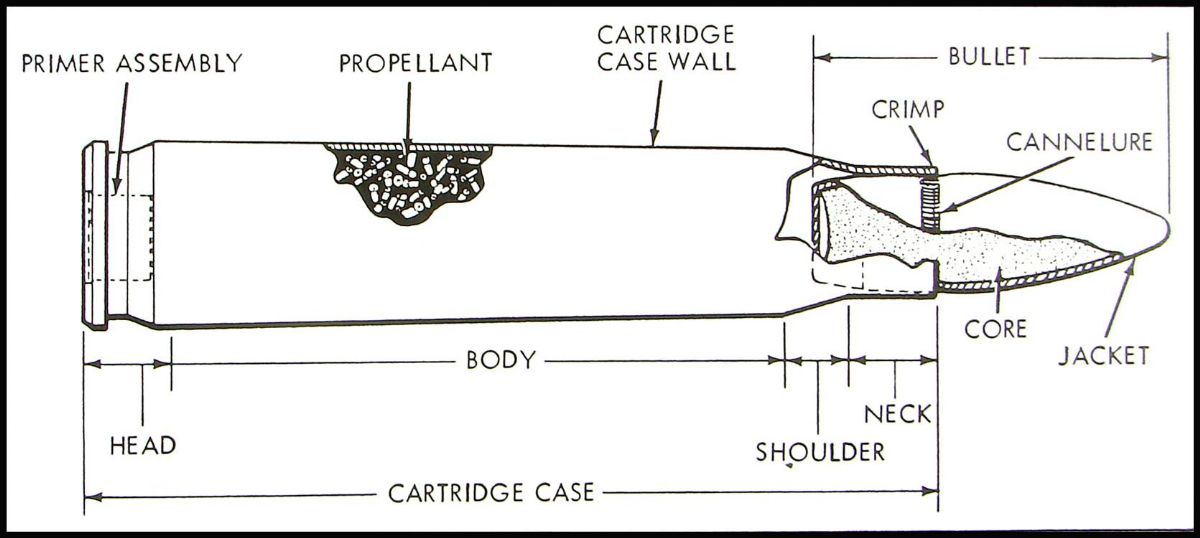 clone: one that appears to be a copy of an original form Part 1 Genuine US Military M193 can no longer be sold to civilians, thanks to the Clinton Administration. The ammunition that is sold on the commercial market with some form of “M193” in its nomenclature is often referred to as an “M193 clone” because it “appears to be a copy” of genuine M193, but we generally have no idea what specifications of MIL-C-9963 that this ammunition has passed, or has even been tested for. Genuine M193 must be tested for and pass all of the specifications laid out in the mil-spec, MIL-C-9963. The required areas of testing included in MIL-C-9963 range from velocity, accuracy, chamber pressure and port pressure to waterproofing, temperature stability, bullet extraction, case hardness, fouling and much more. M193 is loaded with a 55 grain FMJ bullet with a cannelure. The bullet itself, must meet required specifications in order to be used in genuine M193 ammunition. For example, the specification for the thickness of the gilding metal jacket of the bullet is 0.021" with a tolerance of - 0.002". For comparison, the jacket of Hornady’s 55 grain FMJ bullet has a thickness of approximately 0.028”. Jacket thickness can have a significant effect on terminal ballistic properties, particularly that of fragmentation. Even the composition of the copper alloy used for the jacket and the lead used for the slug must meet mil-spec requirements for genuine M193. Genuine M193 can only be charged with powder that has been specifically approved by the US Military for use in this cartridge. If the ammunition in question is not loaded with one of the approved powders, it is not genuine M193 and naturally we have no way of determining what powder was used in a load simply by visual inspection. Genuine M193 will have the annealing iris visible on the shoulder and neck portion of the case. It will also will have crimped and sealed primers. Genuine M193 has a crimped case mouth along with sealant at the case mouth. In 2010, I posted an in-depth evaluation of four different brands of M193 clones that were readily available at that time. (Attack of the (M193) Clones) For this article, I evaluated recent production lots of the same four brands of M193 clones (though not necessarily the same manufacturers.) Winchester M193 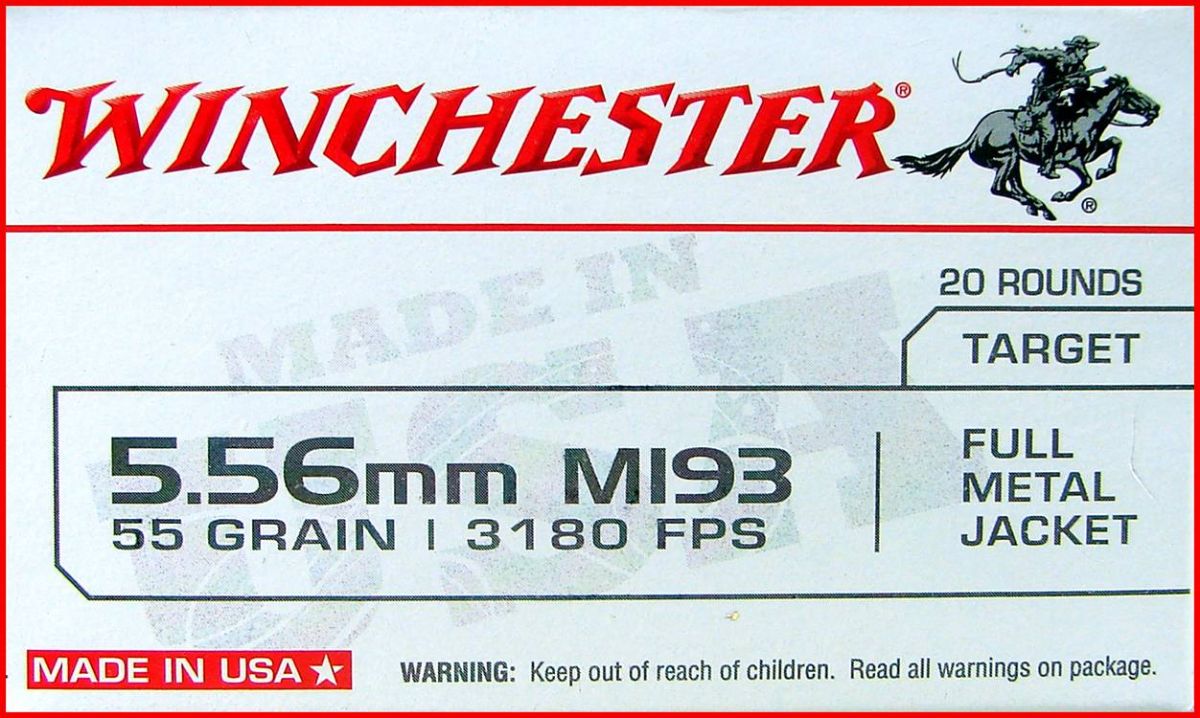 This lot of Winchester M193 is loaded in Lake City brass with a 2021 headstamp. The case-head stamp exhibits the octal station identifiers found on Lake City SCAMP machinery. The brass cases have the annealing iris still visible. The rounds are charged with ball powder. The primer pockets are crimped, but do not have any sealant. The case mouths are also crimped, but also have no sealant. 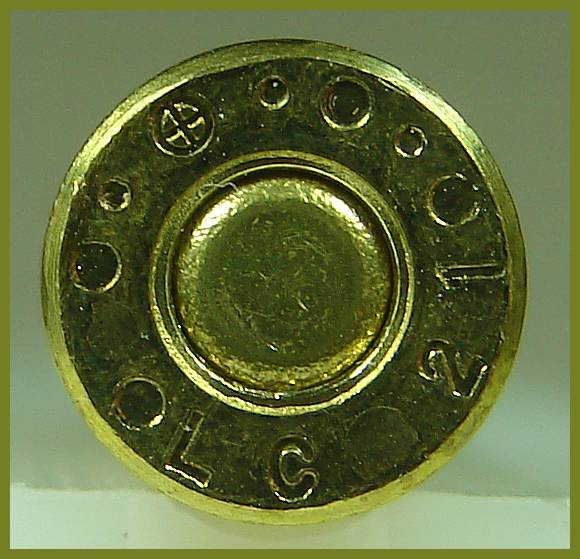 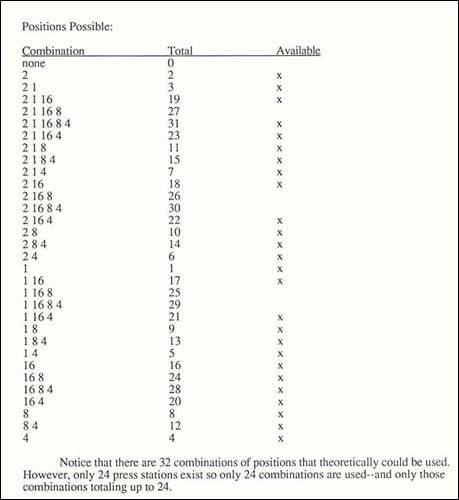 The lot number for this lot of Winchester M193 is pictured below. The “WLC21” in the prefix of the lot number indicates that this lot of Winchester M193 was manufactured at Lake City in 2021 under Winchester “management.”  Federal XM193 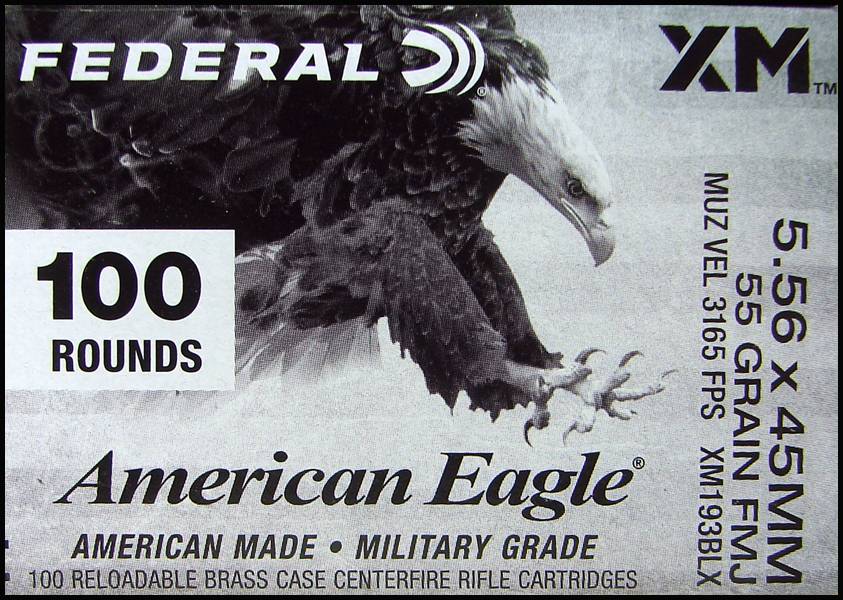 This lot of Federal XM193 is loaded in Lake City brass with a 2021 headstamp. The case-head stamp exhibits the octal station identifiers found on Lake City SCAMP machinery. The brass cases have the annealing iris still visible. The rounds are charged with ball powder. As with the Winchester M193, the primer pockets of this lot of Federal XM193 are crimped, but do not have any sealant. The case mouths of this lot of Federal XM193 are also crimped, but also have no sealant. 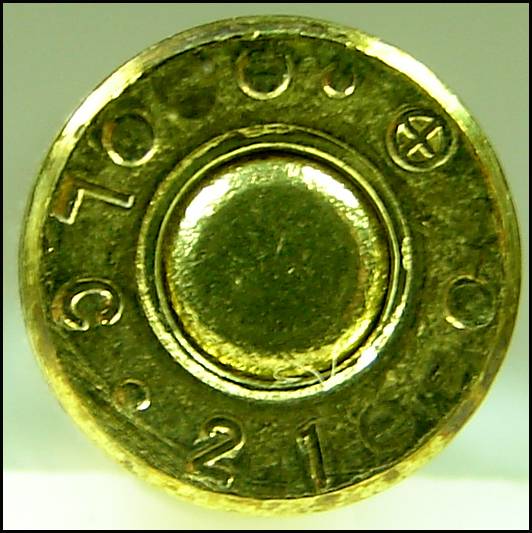 The lot number for this lot of Federal XM193 is pictured below. The “WLC21” in the prefix of the lot number indicates that this lot of Federal XM193 was manufactured at Lake City in 2021 under Winchester “management.”  IMI M193 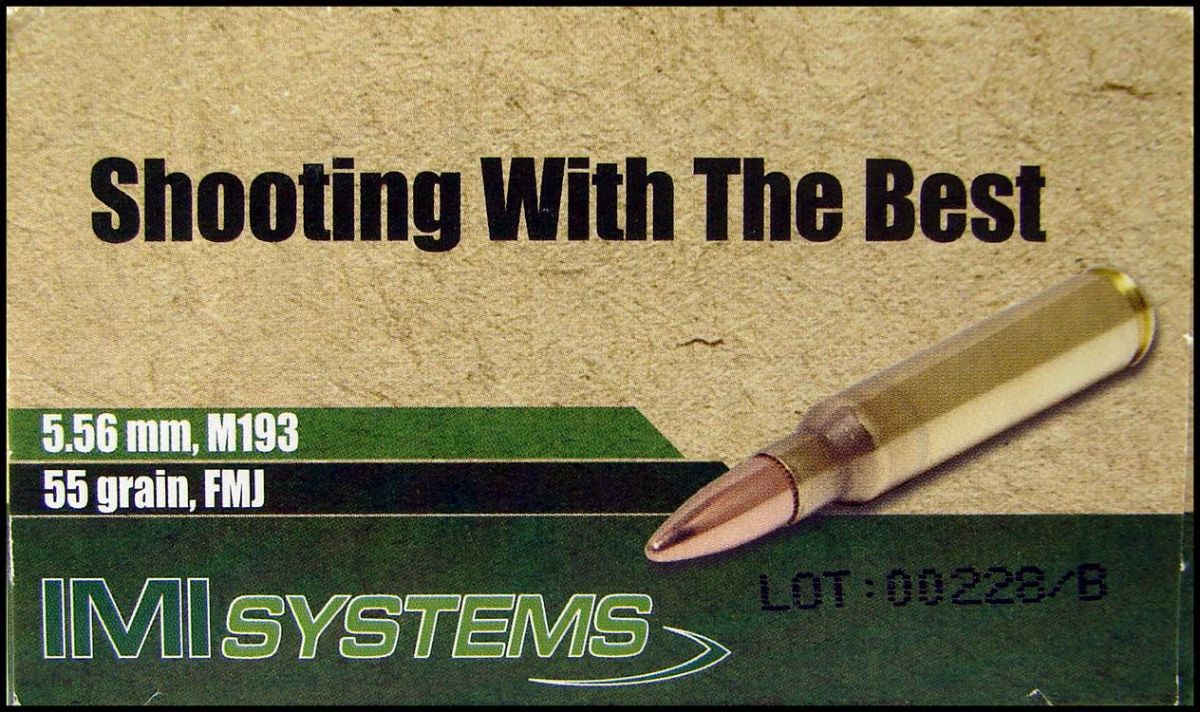 This lot of IMI M193 is loaded in IMI brass with a 2021 headstamp. The annealing iris is visible and the rounds are charged with ball powder. The primer pockets are crimped and sealed and the case mouths are also crimped and sealed. 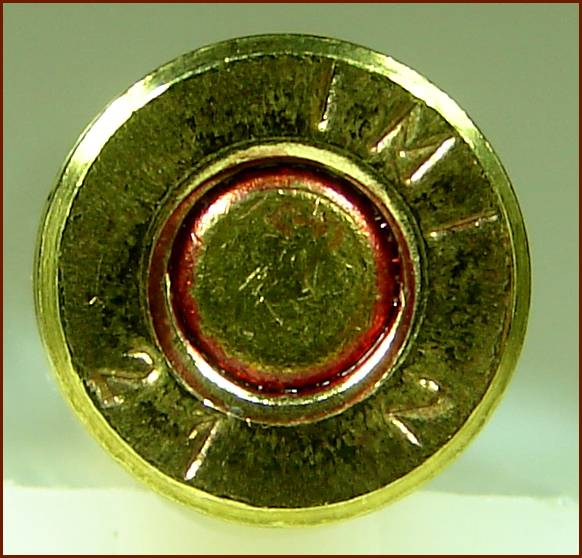 Prvi Partizan (PPU) M193 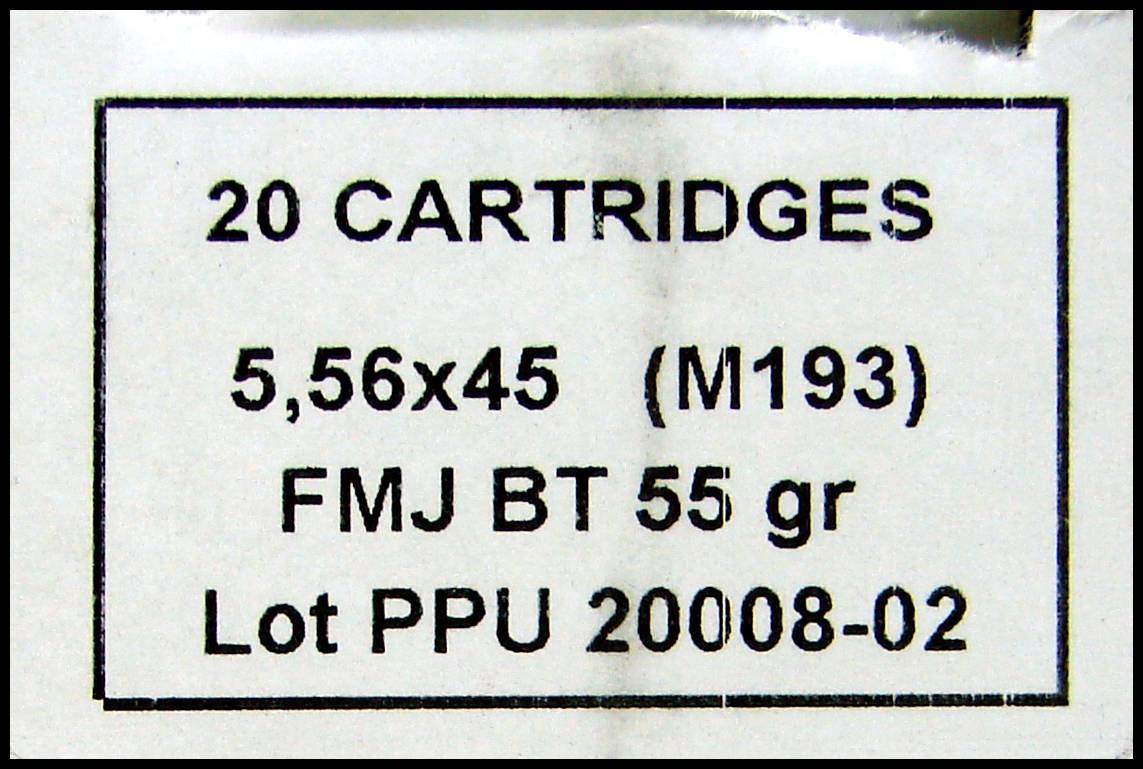 The PPU M193 brass has a 2020 headstamp and the annealing iris is visible. The primer pockets are crimped and sealed, as are the case mouths and the ammunition is charged with ball powder. 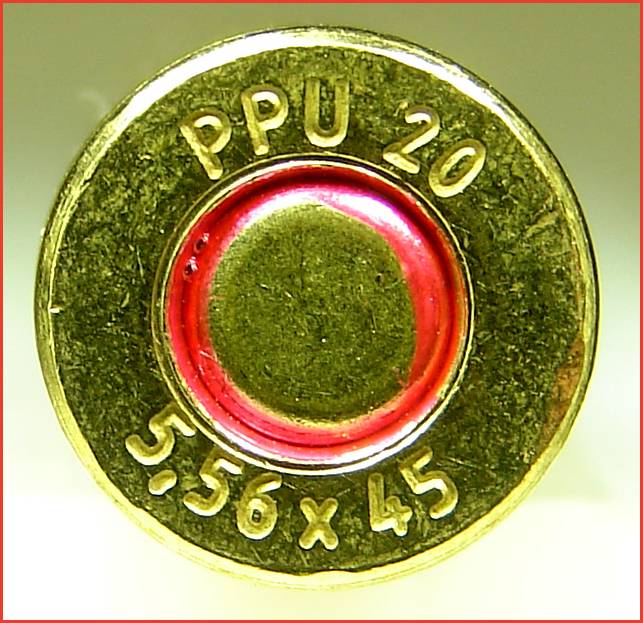 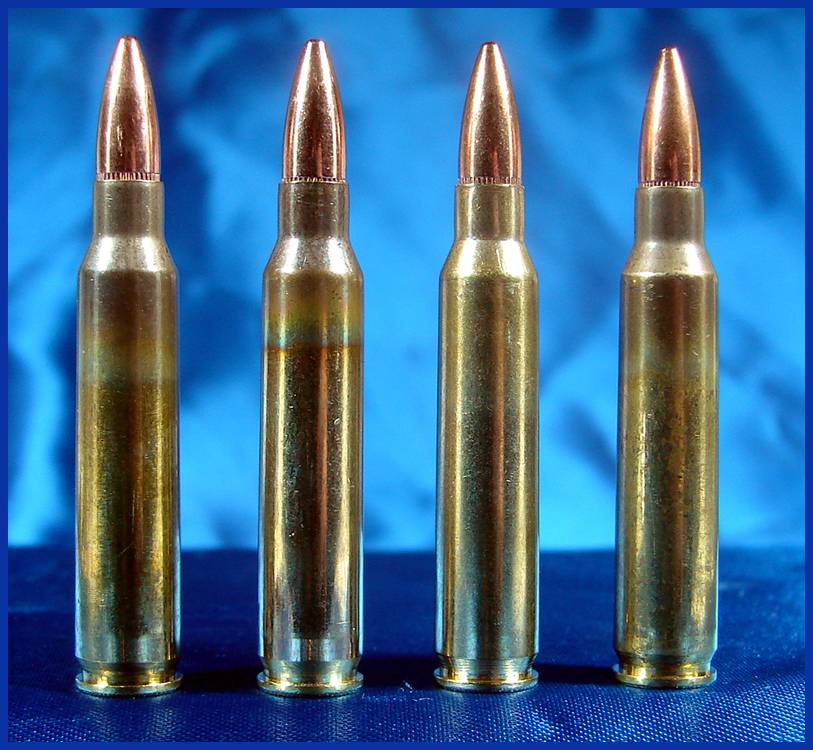 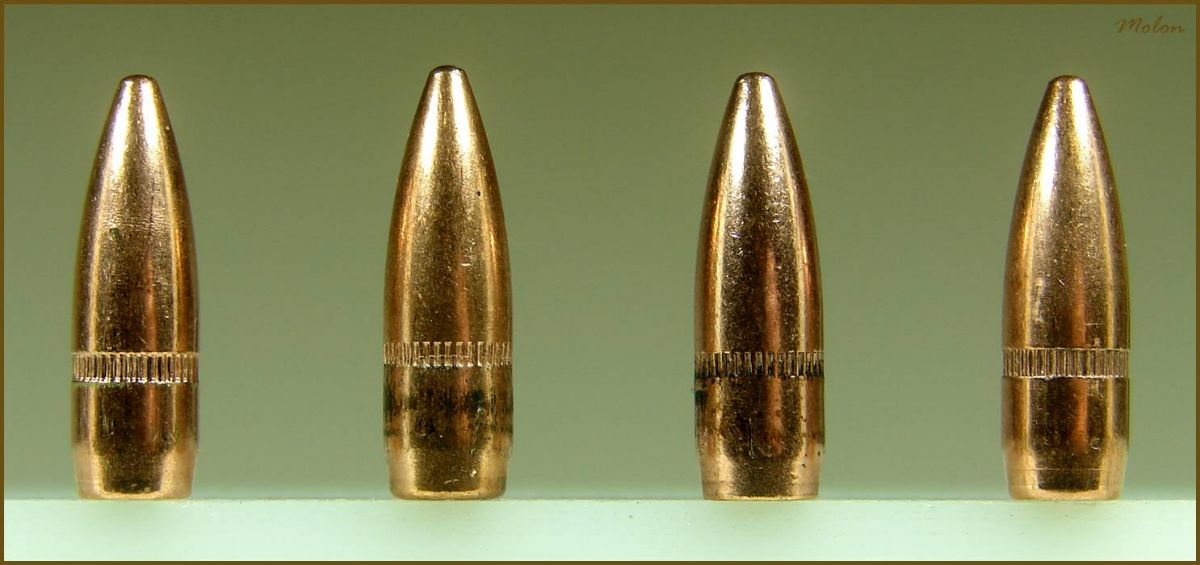 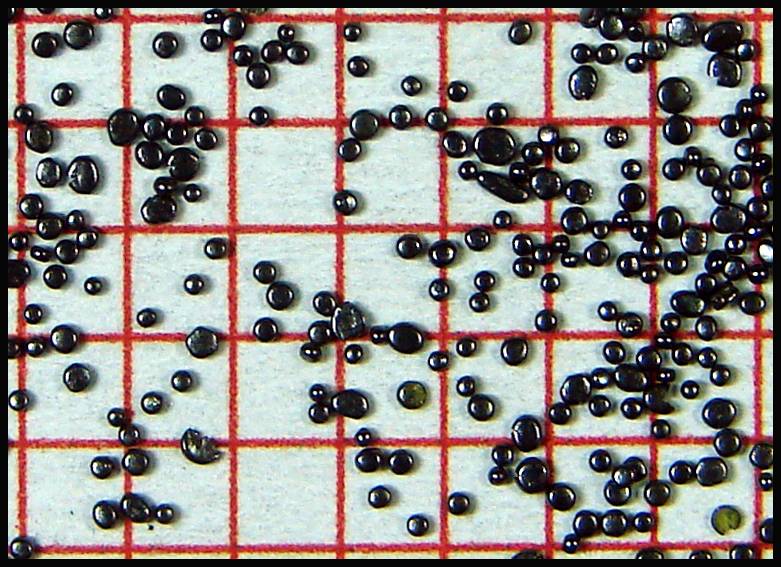 Part 2 Aside from aspects of M193 clones that can be assessed by visual inspection, the two main aspects of M193 clones that we can assess via live fire testing to determine if an M193 clone adheres to the US mil-spec are velocity and accuracy (technically precision). The velocity specification for M193 as cited in MIL-C-9963F states: "The average velocity of the sample cartridges, conditioned at 72 degrees, plus or minus 2 degrees Fahrenheit (F), shall be 3165 feet per second (ft/sec), plus or minus 40 ft/sec, at 78 feet from the muzzle of the weapon. The standard deviation of the velocities shall not exceed 40 ft/sec." The velocity specification is for a 20” test barrel. Depending on multiple variables, this velocity specification equates to a muzzle velocity of approximately 3270 ft/sec, plus or minus 40 ft/sec. As an aside, after reading the above specification, some of you may be wondering, “Why 78 feet from the muzzle?” The answer to that question is that this specification is simply an historical hold-over from the days when “circuit” chronographs (e.g. Le Boulenge Chronograph and the Aberdeen Chronograph) were used at Aberdeen Proving Ground, Frankford Arsenal and Springfield Armory. These types of chronographs required a significant distance between their first and second screens to produce accurate results. As an example, when using the Boulenge Chronograph, the first screen of the chronograph was placed 3 feet in front of the muzzle and the second screen was placed 150 feet beyond the first screen. For those of you who might not be aware of the following fact; chronographs determine the velocity of the bullet at a point that is midway between the first and the second screen (i.e. not at the location of the first screen). Therefore, with the above spacing, the velocity of the bullet is determined for a point that is 75 feet from the first screen. So, add the three feet (from the muzzle to the first screen) to the 75 feet (the midway point of the screens) to obtain the “78 feet from the muzzle” distance.  I chronographed the four M193 clones evaluated for this article from a semi-automatic AR-15 with a chrome-lined, NATO chambered 20” Colt barrel with a 1:7” twist. Chronographing was conducted using an Oehler 35-P chronograph with “proof screen” technology. The Oehler 35P chronograph is actually two chronographs in one package that takes two separate chronograph readings for each shot and then has its onboard computer analyze the data to determine if there is any statistically significant difference between the two readings. If there is, the chronograph “flags” the shot to let you know that the data is invalid. There was no invalid data flagged during this testing. The velocities listed in the table below are muzzle velocities as calculated from the instrumental velocities using Oehler’s Ballistic Explorer software program. Each string of fire consisted of 10 rounds over the chronograph. 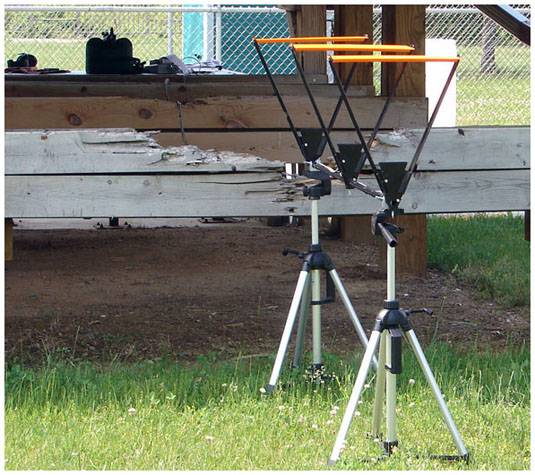  Each round was single-loaded and cycled into the chamber from a magazine fitted with a single-load follower. The bolt locked-back after each shot allowing the chamber to cool in between each shot. This technique was used to mitigate the possible influence of “chamber-soak” on velocity data. Each new shot was fired in a consistent manner after hitting the bolt release. Atmospheric conditions were monitored and recorded using a Kestrel 4000 Pocket Weather Tracker.  Atmospheric conditions Temperature: 72 degrees F Humidity: 78% Barometric pressure: 30.02 inches of Hg Elevation: 950 feet above sea level The muzzle velocities of the four M193 clones are listed in the table below, along with the standard deviations and coefficients of variation. 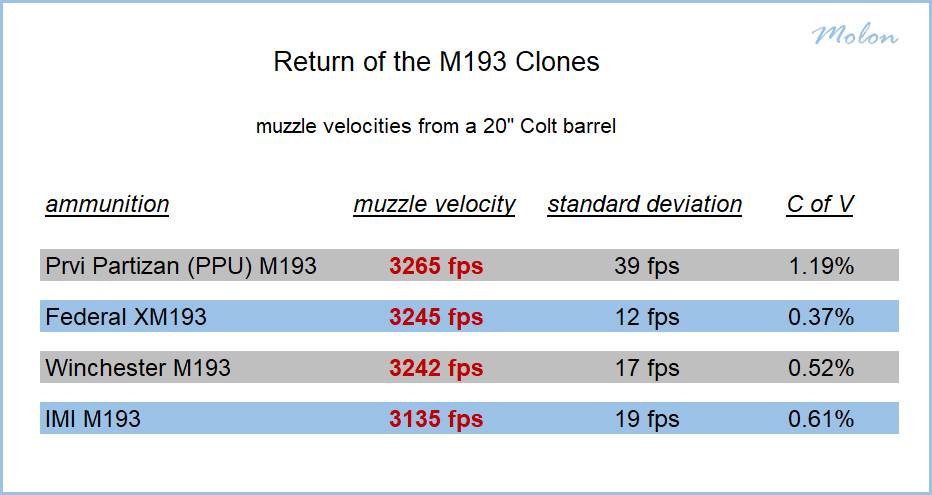 For those of you who might not be familiar with the coefficient of variation (CV), it is the standard deviation, divided by the mean (average) muzzle velocity and then multiplied by 100 and expressed as a percentage. It allows for the comparison of the uniformity of velocity between loads in different velocity spectrums; e.g. 77 grain loads running around 2,650 fps compared to 55 grain loads running around 3,250 fps. The mil-spec for M193 allows for a coefficient of variation of approximately 1.2%, while one of my best 77 grain OTM hand-loads, with a muzzle velocity of 2639 PFS and a standard deviation of 4 FPS, has a coefficient of variation of 0.15%.  For comparison to the velocities of the M193 clones evaluated for this article, the next table shows the muzzle velocities of the four M193 clones that I evaluated in 2010 (also fired from a 20” Colt barrel.) 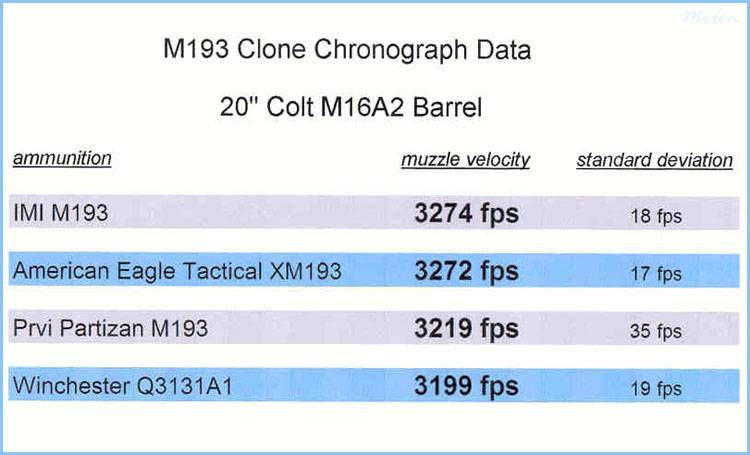 Part 3 The US accuracy specification for M193 cited in MIL-C-9963F is as follows: “The average of the mean radii of all targets of the sample cartridges, fired at 200 yards, shall not exceed 2.0 inches.” These averages are from 10-shot groups fired from machine rested, bolt-actioned, heavy test barrels. All things being equal this specification equates to a mean radius of 1 inch at 100 yards (the distance at which I tested this ammunition). I conducted an accuracy (technically, precision) evaluation of the four M193 clones following my usual protocol. This accuracy evaluation used statistically significant shot-group sizes and every single shot in a fired group was included in the measurements. There was absolutely no use of any Group Reduction Techniques (e.g. fliers, target movement, Butterfly Shots). The shooting set-up will be described in detail below. As many of the significant variables as was practicable were controlled for. Also, a control group was fired from the test-rifle used in the evaluation using match-grade, hand-loaded ammunition; in order to demonstrate the capability of the barrel. Pictures of shot-groups are posted for documentation. All shooting was conducted from a concrete bench-rest from a distance of 100 yards (confirmed with a laser rangefinder.) The barrel used in the evaluation was free-floated. The free-float handguards of the rifle rested in a Sinclair Windage Benchrest, while the stock of the rifle rested in a Protektor bunny-ear rear bag. Sighting was accomplished via a Leupold VARI-X III set at 25X magnification and adjusted to be parallax-free at 100 yards. A mirage shade was used. Wind conditions on the shooting range were continuously monitored using a Wind Probe. The set-up was very similar to that pictured below. 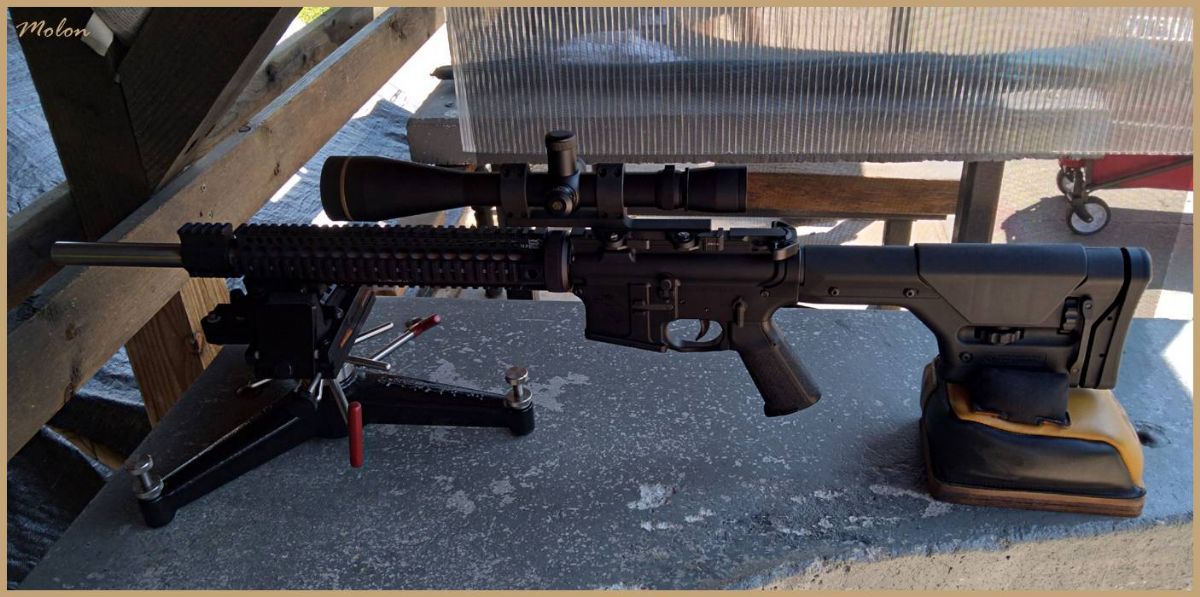 The Wind Probe . . . 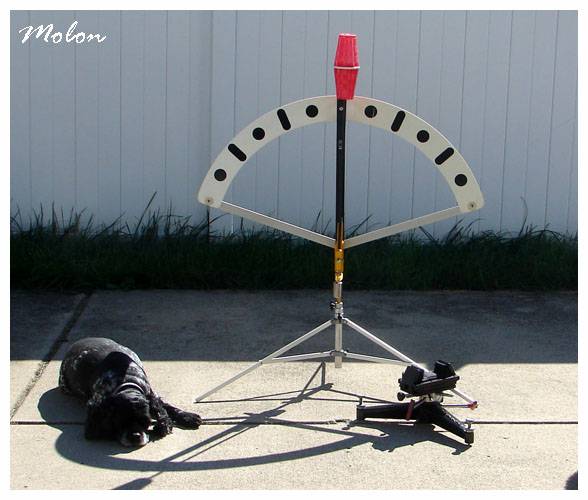 The test vehicle for this evaluation was one of my semi-automatic precision AR-15s with a 20” stainless-steel Lothar Walther barrel. The barrel has a 223 Wylde chamber with a 1:8” twist. 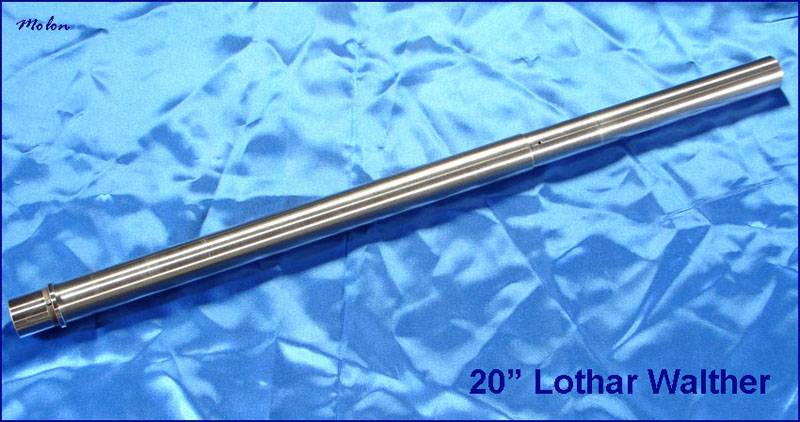 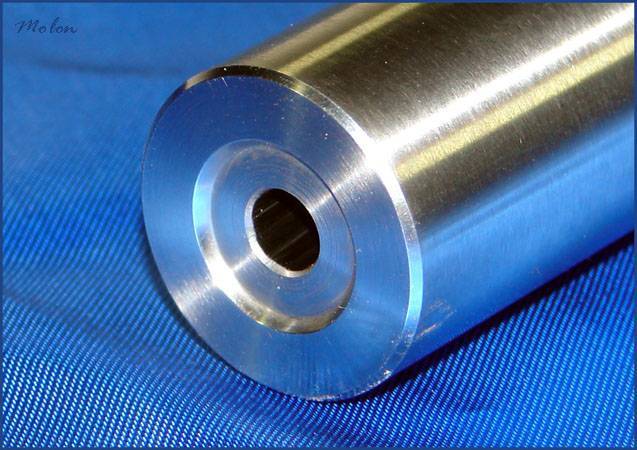 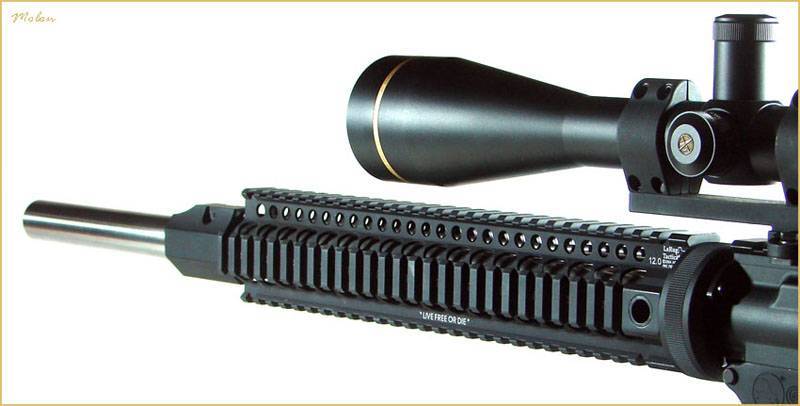 Prior to firing the M193 clones, I fired a 10-shot control group using match-grade hand-loads topped with the Sierra 52 grain MatchKing. That group had an extreme spread of 0.64”. 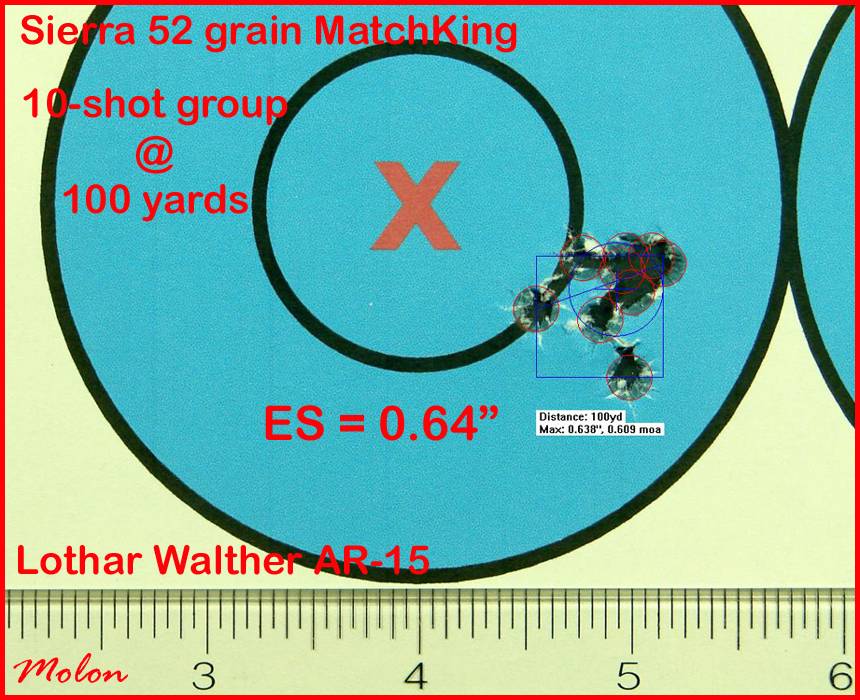 Prvi Partizan (PPU) M193 Three 10-shot groups of the PPU M193 ammunition fired consecutively from the Lothar Walther barreled AR-15 at a distance of 100 yards had the following extreme spreads: 3.00” 2.28” 3.48” for a 10-shot group average extreme spread of 2.92”. I over-layed the three 10-shot groups on each other using RSI Shooting Lab to form a 30-shot composite group. The mean radius of the 30-shot composite group was 0.80”. The smallest 10-shot group . . . 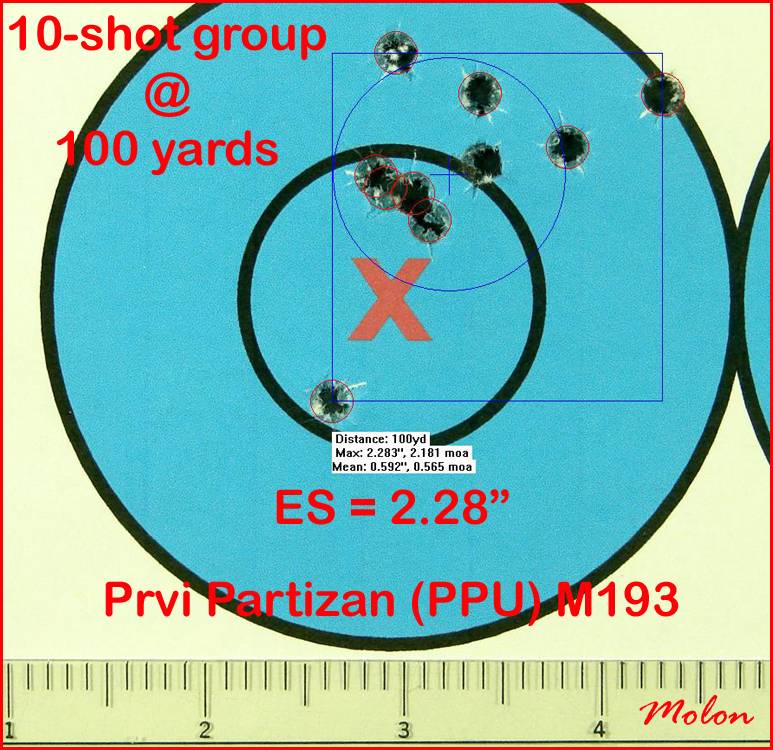 The 30-shot composite group . . . 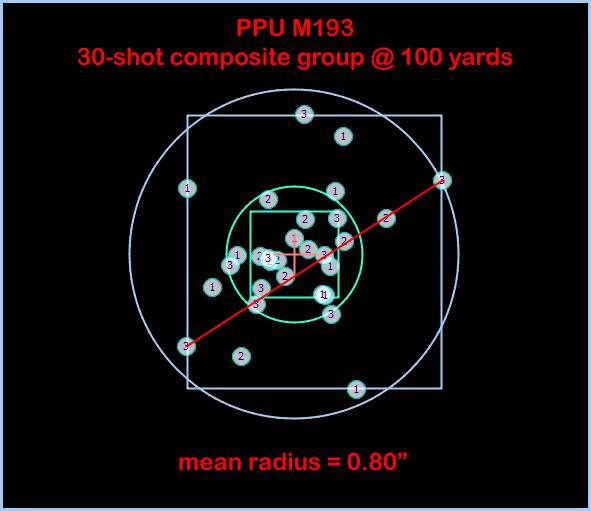 Winchester M193 Three 10-shot groups of the Winchester M193 ammunition fired consecutively from the Lothar Walther barreled AR-15 at a distance of 100 yards had the following extreme spreads: 2.21” 2.65” 2.09” for a 10-shot group average extreme spread of 2.32”. I over-layed the three 10-shot groups on each other using RSI Shooting Lab to form a 30-shot composite group. The mean radius of the 30-shot composite group was 0.72”. The smallest 10-shot group . . . 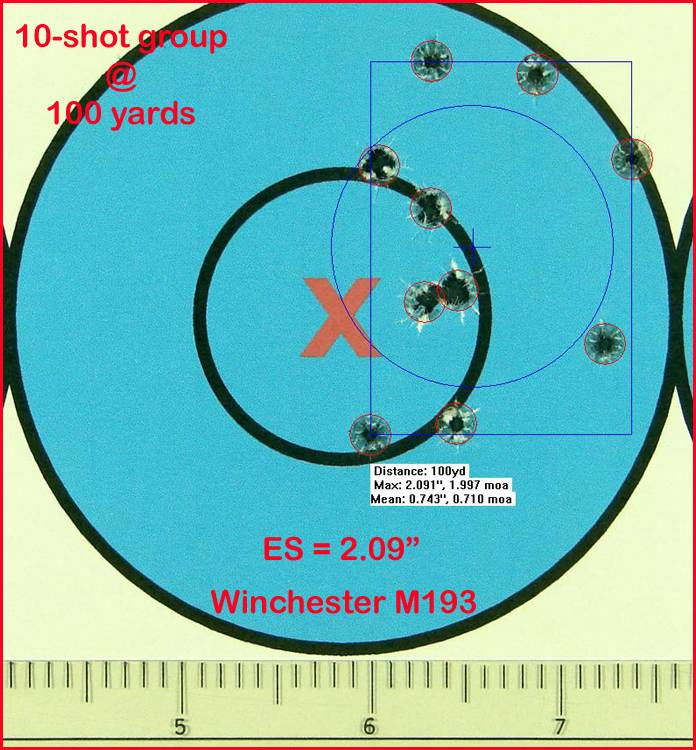 The 30-shot composite group . . . 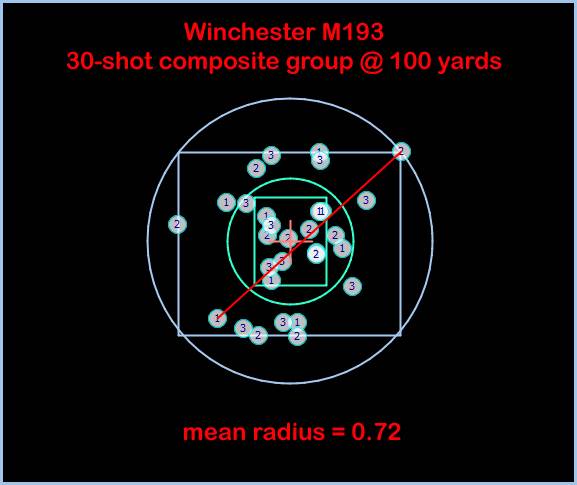 Federal XM193 Three 10-shot groups of the Federal XM193 ammunition fired consecutively from the Lothar Walther barreled AR-15 at a distance of 100 yards had the following extreme spreads: 2.36” 2.67” 1.77” for a 10-shot group average extreme spread of 2.27”. I over-layed the three 10-shot groups on each other using RSI Shooting Lab to form a 30-shot composite group. The mean radius of the 30-shot composite group was 0.66”. The smallest 10-shot group . . . 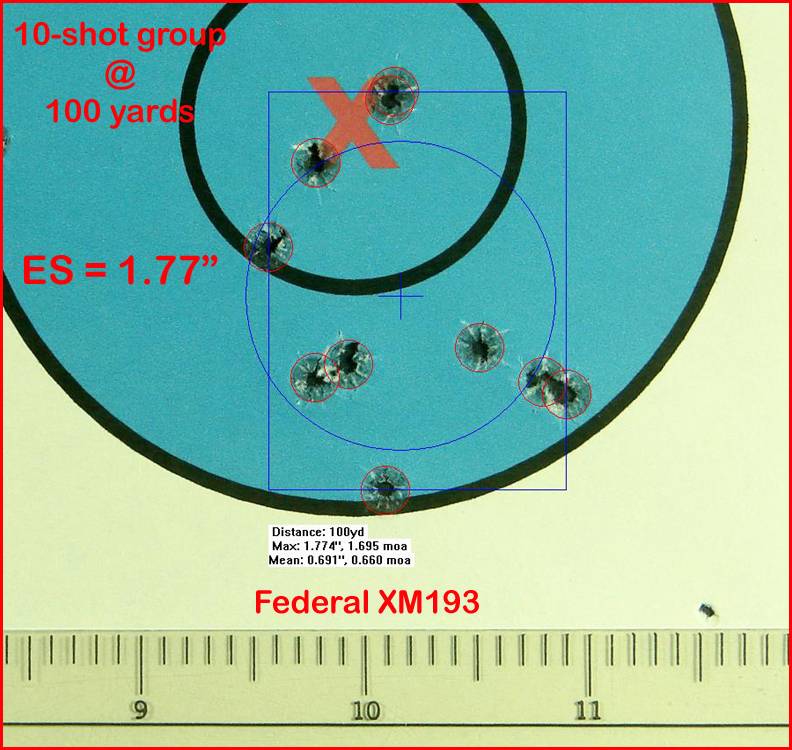 The 30-shot composite group . . . 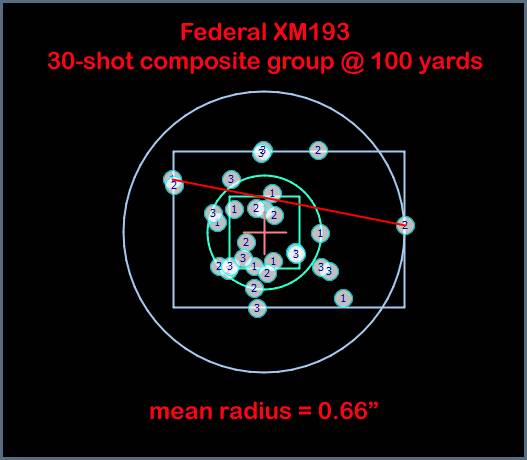 IMI M193 Three 10-shot groups of the IMI M193 ammunition fired consecutively from the Lothar Walther barreled AR-15 at a distance of 100 yards had the following extreme spreads: 1.84” 2.86” 2.16” for a 10-shot group average extreme spread of 2.29”. I over-layed the three 10-shot groups on each other using RSI Shooting Lab to form a 30-shot composite group. The mean radius of the 30-shot composite group was 0.64”. The smallest 10-shot group . . . 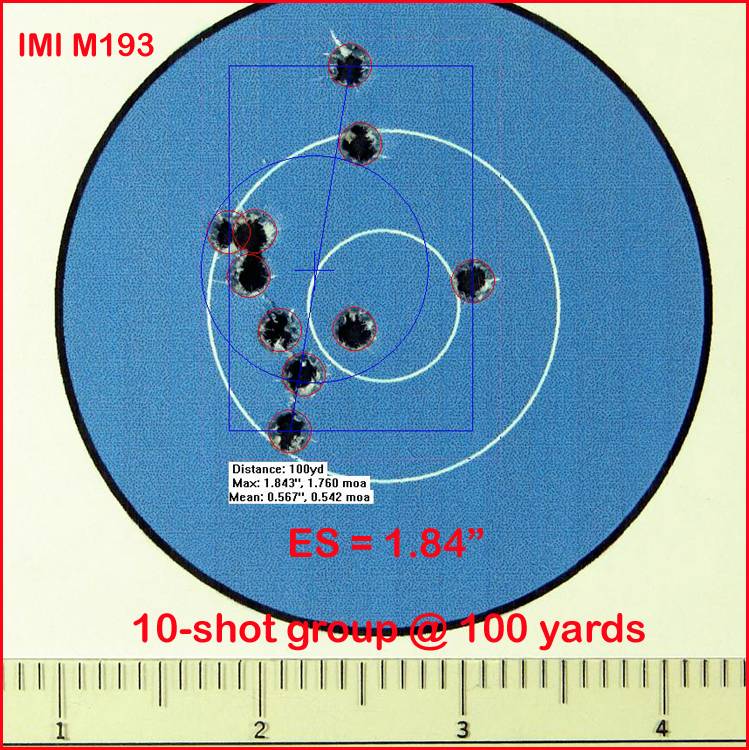 The 30-shot composite group . . . 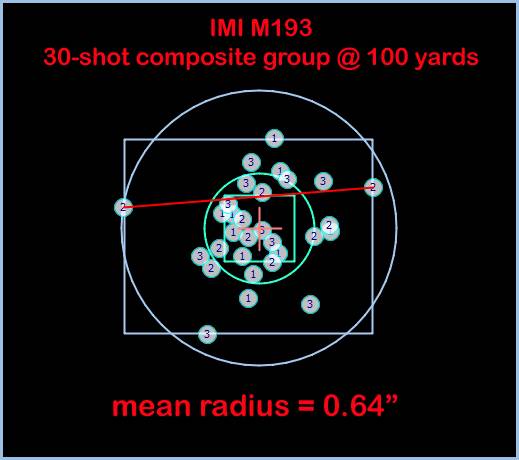 The table below summarizes the accuracy/precision results for this article. 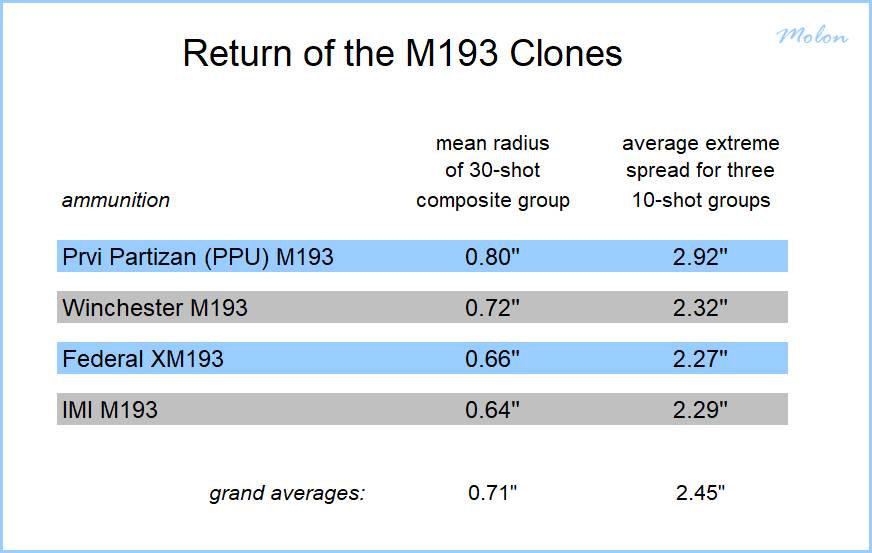 For comparison, the next table summarizes the accuracy/precision results from the 2010 evaluation. 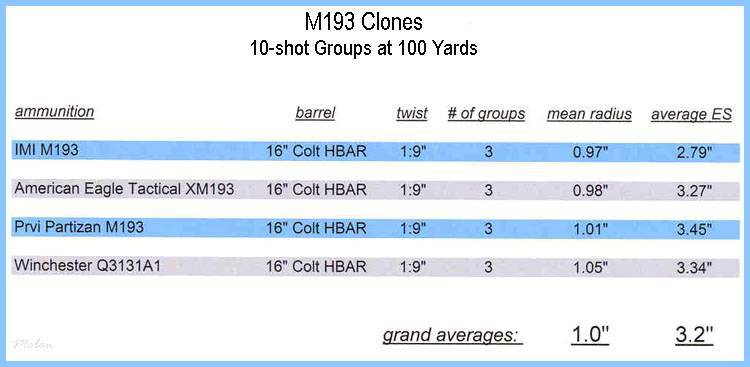  ...... |
|
|
|
[#5]
Biden is threatening to Pull Winchester's Lake City contract if they don't stop selling surplus ammo to civilians.
 BREAKING: Biden Takes Aim At 30% of Civilian .223/5.56 Ammo |
|
|
|
[#6]
Quoted: Biden is threatening to Pull Winchester's Lake City contract if they don't stop selling surplus ammo to civilians. View Quote There's an active thread in GD covering that, this thread is to see if there's an deviations or not between Federal ran LC and Winchester ran LC. |
|
|
|
[#7]
Having shot 1000’s upon 1000’s of rounds of Q3131 i have never had any problems that i recall. I still have a couple cases bought around 2002 that still shoot just fine. I would recommend not leaving it in the cardboard 20rd boxes as i did that with a couple of cases that began to corrode from the cardboard. They ain’t pretty but still go bang as well.
|
|
|
|
[#8]
I have some 2021 LC manufactured M193 in Winchester boxes. She HOT :D I was hitting an average of 3,257 from the 20" when it was 70F outside.
|
|
|
|
[#9]
I've toured that Lake City plant. It's been run by no less than 5 different companies since I toured it in 2011. All that equipment dates from World War II with only minor updates. He can pull Winchester's contract, and someone else will just pick it up and continue to crank out ammo at a loss. There's a reason they sell the surplus.
|
|
|
|
[#10]
After numerous recalls with Winchester 223/5.56, never again
|
|
|
|
[#11]
I have had encountered significant quality problems with Winchester. Hopefully they can't screw up the Lake City plant.
|
|
|
|
[#12]
|
|
|
|
[#13]
|
|
|
|
[#14]
Quoted: Just read this... https://thefederalist.com/2022/06/17/white-house-aims-to-shut-down-ammunition-sales-while-dems-claim-to-engage-in-good-faith-gun-talks/ View Quote Why? What it says has nothing to do with this thread and doesn't answer the OP's question if there are going to be any deviations between the two managements in ammunition quality and consistency. If people want to discuss the attempt by FJB, well there's already an active thread in GD for this purpose. |
|
|
|
[#15]
Quoted: Biden is threatening to Pull Winchester's Lake City contract if they don't stop selling surplus ammo to civilians. View Quote This is wrong. It's not surplus ammo. |
|
|
|
[#16]
My very unscientific opinion. Since this isn't precision ammo I don't shoot it for group other than to check sights. So I'm grading according to often I hit vs. miss the target, steel or clay birds as examples. IME its better than the Winchester 5.56 garbage, maybe equal to slightly worse but definitely not better than the Federal LC 5.56. IOW, o.k for what it is, cheap plinking ammo.
|
|
|
|
[#17]
Quoted: Quoted: Biden is threatening to Pull Winchester's Lake City contract if they don't stop selling surplus ammo to civilians. This is wrong. It's not surplus ammo. Exactly, part of Winchester's contract to operate the Lake City plant allows Winchester to load some amount of ammunition for commercial sales there. If they aren't allowed to make that money, the government would have to compensate Winchester by paying them more money to operate the plant. |
|
|
|
[#18]
Quoted: Curious if this is just run of the mill Lake City M193/M855 like always or if Winchester has changed anything with it. I've been disappointed with actual Winchester made 5.56 and was wondering if the Lake City stuff si worth taking a look at. View Quote I shot 3 boxes of the 150(?) rounds. It’s typical LC ammo. No issues with it. Shot it out of 5 different rifles and they all functioned and accuracy was normal for M193. There was no M855 ball at the time. There is now at my local shop. I was thinking about picking some up. |
|
|
|
[#19]
Quoted: Biden is threatening to Pull Winchester's Lake City contract if they don't stop selling surplus ammo to civilians. View Quote Maybe they can just stop selling to the Federal gov't. I'm sure civilians would happily buy it all up, assuming the quality doesn't decline. |
|
|
|
[#20]
|
|
|
|
[#21]
Quoted: Maybe they can just stop selling to the Federal gov't. I'm sure civilians would happily buy it all up, assuming the quality doesn't decline. View Quote View All Quotes View All Quotes Quoted: Quoted: Biden is threatening to Pull Winchester's Lake City contract if they don't stop selling surplus ammo to civilians. Maybe they can just stop selling to the Federal gov't. I'm sure civilians would happily buy it all up, assuming the quality doesn't decline. Or we could not feed a troll trying to derail a thread about asking if there's been any accuracy deviations between Federal ran and Winchester run Lake City ammunition, and replaced with his GD topic about politics concerning the plant and Biden (which has nothing to do with what the OP was asking by the way). |
|
|
|
[#22]
Quoted: Or we could not feed a troll trying to derail a thread about asking if there's been any accuracy deviations between Federal ran and Winchester run Lake City ammunition, and replaced with his GD topic about politics concerning the plant and Biden (which has nothing to do with what the OP was asking by the way). View Quote Damn, stop with the screeching. |
|
|
|
[#23]
Thanks Molon.
Disappointed that its not sealed like when Federal ran LC. Possibly just this lot? Can anyone confirm that their Winchester LC 5.56 is sealed or not? I know it is not all that necessary to be mil. spec. sealed, but its my preference for ammo going into storage. |
|
|
|
[#24]
|
|
|
|
[#25]
The guy at SGAMMO says the Winchester ammo made at Lake City is the same as the Federal made there.
But the Winchester shoots terrible and the Federal much better in my AR. IMI outshoots them both by a noticeable margin! Norma shoots 1.25 groups at 50 yards!! Get some!!! |
|
|
|
[#26]
Quoted: The guy at SGAMMO says the Winchester ammo made at Lake City is the same as the Federal made there. But the Winchester shoots terrible and the Federal much better in my AR View Quote https://www.ar15.com/forums/general/Return-of-the-M193-Clones/5-2515258/ ... |
|
|
|
[#27]
Quoted: The guy at SGAMMO says the Winchester ammo made at Lake City is the same as the Federal made there. But the Winchester shoots terrible and the Federal much better in my AR. IMI outshoots them both by a noticeable margin! Norma shoots 1.25 groups at 50 yards!! Get some!!! View Quote Norma has a contract for LC made 223. Go get some indeed!!!!!!!!!!!!!!!!!!!!!!!!!!!!!!! And looking at Molon's results in this very same thread, there's not much of a big difference between groups with all three other than splitting hairs over millimeters. |
|
|
|
[#28]
Quoted: https://www.ar15.com/forums/general/Return-of-the-M193-Clones/5-2515258/ Return Of The M193 Clones https://www.ar15.com/media/mediaFiles/28568/223_cartridge_drawing_005-2200622.jpg clone: one that appears to be a copy of an original form Part 1 Genuine US Military M193 can no longer be sold to civilians, thanks to the Clinton Administration. The ammunition that is sold on the commercial market with some form of “M193” in its nomenclature is often referred to as an “M193 clone” because it “appears to be a copy” of genuine M193, but we generally have no idea what specifications of MIL-C-9963 that this ammunition has passed, or has even been tested for. Genuine M193 must be tested for and pass all of the specifications laid out in the mil-spec, MIL-C-9963. The required areas of testing included in MIL-C-9963 range from velocity, accuracy, chamber pressure and port pressure to waterproofing, temperature stability, bullet extraction, case hardness, fouling and much more. M193 is loaded with a 55 grain FMJ bullet with a cannelure. The bullet itself, must meet required specifications in order to be used in genuine M193 ammunition. For example, the specification for the thickness of the gilding metal jacket of the bullet is 0.021" with a tolerance of - 0.002". For comparison, the jacket of Hornady’s 55 grain FMJ bullet has a thickness of approximately 0.028”. Jacket thickness can have a significant effect on terminal ballistic properties, particularly that of fragmentation. Even the composition of the copper alloy used for the jacket and the lead used for the slug must meet mil-spec requirements for genuine M193. Genuine M193 can only be charged with powder that has been specifically approved by the US Military for use in this cartridge. If the ammunition in question is not loaded with one of the approved powders, it is not genuine M193 and naturally we have no way of determining what powder was used in a load simply by visual inspection. Genuine M193 will have the annealing iris visible on the shoulder and neck portion of the case. It will also will have crimped and sealed primers. Genuine M193 has a crimped case mouth along with sealant at the case mouth. In 2010, I posted an in-depth evaluation of four different brands of M193 clones that were readily available at that time. (Attack of the (M193) Clones) For this article, I evaluated recent production lots of the same four brands of M193 clones (though not necessarily the same manufacturers.) Winchester M193 https://www.ar15.com/media/mediaFiles/28568/winchester_m183_box_2021-2210446.jpg This lot of Winchester M193 is loaded in Lake City brass with a 2021 headstamp. The case-head stamp exhibits the octal station identifiers found on Lake City SCAMP machinery. The brass cases have the annealing iris still visible. The rounds are charged with ball powder. The primer pockets are crimped, but do not have any sealant. The case mouths are also crimped, but also have no sealant. https://www.ar15.com/media/mediaFiles/28568/winchester_m193_headstamp_2021-2210472.jpg https://www.ar15.com/media/mediaFiles/28568/lake_city_scamp_octal__numbering_03_resi-2209035.jpg The lot number for this lot of Winchester M193 is pictured below. The “WLC21” in the prefix of the lot number indicates that this lot of Winchester M193 was manufactured at Lake City in 2021 under Winchester “management.” https://www.ar15.com/media/mediaFiles/28568/winchester_m193_lot_number_2021-2210503.jpg Federal XM193 https://www.ar15.com/media/mediaFiles/28568/federal_xm193_box_2021-2210443.jpg This lot of Federal XM193 is loaded in Lake City brass with a 2021 headstamp. The case-head stamp exhibits the octal station identifiers found on Lake City SCAMP machinery. The brass cases have the annealing iris still visible. The rounds are charged with ball powder. As with the Winchester M193, the primer pockets of this lot of Federal XM193 are crimped, but do not have any sealant. The case mouths of this lot of Federal XM193 are also crimped, but also have no sealant. https://www.ar15.com/media/mediaFiles/28568/federal_xm193_headstamp_2021-2209028.jpg The lot number for this lot of Federal XM193 is pictured below. The “WLC21” in the prefix of the lot number indicates that this lot of Federal XM193 was manufactured at Lake City in 2021 under Winchester “management.” https://www.ar15.com/media/mediaFiles/28568/federal_xm193_lot_number_2021-2210512.jpg IMI M193 https://www.ar15.com/media/mediaFiles/28568/imi_m193_box_2021_resized-2210444.jpg This lot of IMI M193 is loaded in IMI brass with a 2021 headstamp. The annealing iris is visible and the rounds are charged with ball powder. The primer pockets are crimped and sealed and the case mouths are also crimped and sealed. https://www.ar15.com/media/mediaFiles/28568/imi_headstamp_2021-2210584.jpg Prvi Partizan (PPU) M193 https://www.ar15.com/media/mediaFiles/28568/ppu_m193_box_2020-2210445.jpg The PPU M193 brass has a 2020 headstamp and the annealing iris is visible. The primer pockets are crimped and sealed, as are the case mouths and the ammunition is charged with ball powder. https://www.ar15.com/media/mediaFiles/28568/ppu_m193_headstamp_2020_01-2210797.jpg https://www.ar15.com/media/mediaFiles/28568/four_m193_clones_2021_01_resized-2211131.jpg https://www.ar15.com/media/mediaFiles/28568/pulled_m193_bullets_2021_02-2211143.jpg https://www.ar15.com/media/mediaFiles/28568/m193_clone_2021_powder_01-2211151.jpg Part 2 Aside from aspects of M193 clones that can be assessed by visual inspection, the two main aspects of M193 clones that we can assess via live fire testing to determine if an M193 clone adheres to the US mil-spec are velocity and accuracy (technically precision). The velocity specification for M193 as cited in MIL-C-9963F states: "The average velocity of the sample cartridges, conditioned at 72 degrees, plus or minus 2 degrees Fahrenheit (F), shall be 3165 feet per second (ft/sec), plus or minus 40 ft/sec, at 78 feet from the muzzle of the weapon. The standard deviation of the velocities shall not exceed 40 ft/sec." The velocity specification is for a 20” test barrel. Depending on multiple variables, this velocity specification equates to a muzzle velocity of approximately 3270 ft/sec, plus or minus 40 ft/sec. As an aside, after reading the above specification, some of you may be wondering, “Why 78 feet from the muzzle?” The answer to that question is that this specification is simply an historical hold-over from the days when “circuit” chronographs (e.g. Le Boulenge Chronograph and the Aberdeen Chronograph) were used at Aberdeen Proving Ground, Frankford Arsenal and Springfield Armory. These types of chronographs required a significant distance between their first and second screens to produce accurate results. As an example, when using the Boulenge Chronograph, the first screen of the chronograph was placed 3 feet in front of the muzzle and the second screen was placed 150 feet beyond the first screen. For those of you who might not be aware of the following fact; chronographs determine the velocity of the bullet at a point that is midway between the first and the second screen (i.e. not at the location of the first screen). Therefore, with the above spacing, the velocity of the bullet is determined for a point that is 75 feet from the first screen. So, add the three feet (from the muzzle to the first screen) to the 75 feet (the midway point of the screens) to obtain the “78 feet from the muzzle” distance. https://www.ar15.com/media/mediaFiles/28568/chronograph_spacing_44-1845418.jpg I chronographed the four M193 clones evaluated for this article from a semi-automatic AR-15 with a chrome-lined, NATO chambered 20” Colt barrel with a 1:7” twist. Chronographing was conducted using an Oehler 35-P chronograph with “proof screen” technology. The Oehler 35P chronograph is actually two chronographs in one package that takes two separate chronograph readings for each shot and then has its onboard computer analyze the data to determine if there is any statistically significant difference between the two readings. If there is, the chronograph “flags” the shot to let you know that the data is invalid. There was no invalid data flagged during this testing. The velocities listed in the table below are muzzle velocities as calculated from the instrumental velocities using Oehler’s Ballistic Explorer software program. Each string of fire consisted of 10 rounds over the chronograph. https://www.ar15.com/media/mediaFiles/28568/oehler_chronograph_32-1342454.jpg https://www.ar15.com/media/mediaFiles/28568/oehler_computer_02-1342452.jpg Each round was single-loaded and cycled into the chamber from a magazine fitted with a single-load follower. The bolt locked-back after each shot allowing the chamber to cool in between each shot. This technique was used to mitigate the possible influence of “chamber-soak” on velocity data. Each new shot was fired in a consistent manner after hitting the bolt release. Atmospheric conditions were monitored and recorded using a Kestrel 4000 Pocket Weather Tracker. https://www.ar15.com/media/mediaFiles/28568/kestrel_4000_21-1342442.jpg Atmospheric conditions Temperature: 72 degrees F Humidity: 78% Barometric pressure: 30.02 inches of Hg Elevation: 950 feet above sea level The muzzle velocities of the four M193 clones are listed in the table below, along with the standard deviations and coefficients of variation. https://www.ar15.com/media/mediaFiles/28568/return_of_the_m193_clones_muzzle_velocit-2210949.jpg For those of you who might not be familiar with the coefficient of variation (CV), it is the standard deviation, divided by the mean (average) muzzle velocity and then multiplied by 100 and expressed as a percentage. It allows for the comparison of the uniformity of velocity between loads in different velocity spectrums; e.g. 77 grain loads running around 2,650 fps compared to 55 grain loads running around 3,250 fps. The mil-spec for M193 allows for a coefficient of variation of approximately 1.2%, while one of my best 77 grain OTM hand-loads, with a muzzle velocity of 2639 PFS and a standard deviation of 4 FPS, has a coefficient of variation of 0.15%. https://www.ar15.com/media/mediaFiles/28568/stnadard_deviation_of_4_fps_01-1342455.jpg For comparison to the velocities of the M193 clones evaluated for this article, the next table shows the muzzle velocities of the four M193 clones that I evaluated in 2010 (also fired from a 20” Colt barrel.) https://www.ar15.com/media/mediaFiles/28568/m193_chronograph_chart_01-1426669-2210773.jpg Part 3 The US accuracy specification for M193 cited in MIL-C-9963F is as follows: “The average of the mean radii of all targets of the sample cartridges, fired at 200 yards, shall not exceed 2.0 inches.” These averages are from 10-shot groups fired from machine rested, bolt-actioned, heavy test barrels. All things being equal this specification equates to a mean radius of 1 inch at 100 yards (the distance at which I tested this ammunition). I conducted an accuracy (technically, precision) evaluation of the four M193 clones following my usual protocol. This accuracy evaluation used statistically significant shot-group sizes and every single shot in a fired group was included in the measurements. There was absolutely no use of any Group Reduction Techniques (e.g. fliers, target movement, Butterfly Shots). The shooting set-up will be described in detail below. As many of the significant variables as was practicable were controlled for. Also, a control group was fired from the test-rifle used in the evaluation using match-grade, hand-loaded ammunition; in order to demonstrate the capability of the barrel. Pictures of shot-groups are posted for documentation. All shooting was conducted from a concrete bench-rest from a distance of 100 yards (confirmed with a laser rangefinder.) The barrel used in the evaluation was free-floated. The free-float handguards of the rifle rested in a Sinclair Windage Benchrest, while the stock of the rifle rested in a Protektor bunny-ear rear bag. Sighting was accomplished via a Leupold VARI-X III set at 25X magnification and adjusted to be parallax-free at 100 yards. A mirage shade was used. Wind conditions on the shooting range were continuously monitored using a Wind Probe. The set-up was very similar to that pictured below. https://www.ar15.com/media/mediaFiles/28568/lothar_walther_ar15_on_bench_03-2211995.jpg The Wind Probe . . . https://www.ar15.com/media/mediaFiles/28568/wind_probe_2016_01_framedb-1342522.jpg The test vehicle for this evaluation was one of my semi-automatic precision AR-15s with a 20” stainless-steel Lothar Walther barrel. The barrel has a 223 Wylde chamber with a 1:8” twist. https://www.ar15.com/media/mediaFiles/28568/lothar_walther_barrel_21_resized-1999713.jpg https://www.ar15.com/media/mediaFiles/28568/lothar_barrel_crown_02_resized-1297385-1342445.jpg https://www.ar15.com/media/mediaFiles/28568/lothar_walther_barrel_free_floated_05-12-1342446.jpg Prior to firing the M193 clones, I fired a 10-shot control group using match-grade hand-loads topped with the Sierra 52 grain MatchKing. That group had an extreme spread of 0.64”. https://www.ar15.com/media/mediaFiles/28568/52_smk_control_group_for_rotmc_lothar_ba-2211589.jpg Prvi Partizan (PPU) M193 Three 10-shot groups of the PPU M193 ammunition fired consecutively from the Lothar Walther barreled AR-15 at a distance of 100 yards had the following extreme spreads: 3.00” 2.28” 3.48” for a 10-shot group average extreme spread of 2.92”. I over-layed the three 10-shot groups on each other using RSI Shooting Lab to form a 30-shot composite group. The mean radius of the 30-shot composite group was 0.80”. The smallest 10-shot group . . . https://www.ar15.com/media/mediaFiles/28568/ppu_m193_2020_10_shot_group_at_100_yards-2211631.jpg The 30-shot composite group . . . https://www.ar15.com/media/mediaFiles/28568/ppu_m193_2020_30_shot_composite_group_01-2211650.jpg Winchester M193 Three 10-shot groups of the Winchester M193 ammunition fired consecutively from the Lothar Walther barreled AR-15 at a distance of 100 yards had the following extreme spreads: 2.21” 2.65” 2.09” for a 10-shot group average extreme spread of 2.32”. I over-layed the three 10-shot groups on each other using RSI Shooting Lab to form a 30-shot composite group. The mean radius of the 30-shot composite group was 0.72”. The smallest 10-shot group . . . https://www.ar15.com/media/mediaFiles/28568/winchester_m193_2021_10_shot_group_at_10-2211704.jpg The 30-shot composite group . . . https://www.ar15.com/media/mediaFiles/28568/winchester_m193_2021_30_shot_composite_g-2211723.jpg Federal XM193 Three 10-shot groups of the Federal XM193 ammunition fired consecutively from the Lothar Walther barreled AR-15 at a distance of 100 yards had the following extreme spreads: 2.36” 2.67” 1.77” for a 10-shot group average extreme spread of 2.27”. I over-layed the three 10-shot groups on each other using RSI Shooting Lab to form a 30-shot composite group. The mean radius of the 30-shot composite group was 0.66”. The smallest 10-shot group . . . https://www.ar15.com/media/mediaFiles/28568/federal_xm193_2021_smallest_10_shot_grou-2211782.jpg The 30-shot composite group . . . https://www.ar15.com/media/mediaFiles/28568/federal_xm193_30_shot_comosite_group_001-2211907.jpg IMI M193 Three 10-shot groups of the IMI M193 ammunition fired consecutively from the Lothar Walther barreled AR-15 at a distance of 100 yards had the following extreme spreads: 1.84” 2.86” 2.16” for a 10-shot group average extreme spread of 2.29”. I over-layed the three 10-shot groups on each other using RSI Shooting Lab to form a 30-shot composite group. The mean radius of the 30-shot composite group was 0.64”. The smallest 10-shot group . . . https://www.ar15.com/media/mediaFiles/28568/imi_m193_2021_228b_01_measured_01-2211933.jpg The 30-shot composite group . . . https://www.ar15.com/media/mediaFiles/28568/imi_m193_lot_228b_30_shot_composite_01-2211945.jpg The table below summarizes the accuracy/precision results for this article. https://www.ar15.com/media/mediaFiles/28568/return_of_the_m193_accuracy_results_tabl-2211974.jpg For comparison, the next table summarizes the accuracy/precision results from the 2010 evaluation. https://www.ar15.com/media/mediaFiles/28568/m193_clone_accuracy_chart_02-1426653-2211978.jpg https://www.ar15.com/media/mediaFiles/28568/molon_sig_gray_arfcom_background_002-1833285.jpg ...... View Quote Very nice write up Molon. I have seen your posts around from old threads. So based on your results, which appear to line up with the old 2010? study, IMI would be the round to go with if I were to order "M193". I am getting ready for work and had to quickly browse over your elaborate post. Thanks for posting. Molon, do you know anything about this early 2000s Century Arms surplus M193 thats floating around right now? I need to grab some ammo. |
|
|
|
[#30]
|
|
|
|
[#31]
Quoted: Quoted: Molon, do you know anything about this early 2000s Century Arms surplus M193 thats floating around right now? I need to grab some ammo. I'm afraid not. ... Produced by Magtech. I’m sure it’s 100% fine as it’s been in sealed ammo cans (allegedly in climate control) and bullet and primer are both seed as well. Velocity should be good too since mid 2000’s production vs newer M193 that’s been neutered. I recently got some new production Magtech M193 to try and was a little dissappointed in velocity as it’s suppose to still be loaded to true M193 spec. Averaged 3084 fps out of a BA 16”. Wolf gold averaged 3098. New production Winchester/LC M193 averaged 3167! |
|
|
|
[#32]
Quoted: Thanks Molon. Disappointed that its not sealed like when Federal ran LC. Possibly just this lot? Can anyone confirm that their Winchester LC 5.56 is sealed or not? I know it is not all that necessary to be mil. spec. sealed, but its my preference for ammo going into storage. View Quote Recently purchased Winchester/LC M193. No sealant on primer or bullet. Winchester/LC M855 has the thicker black bullet sealant and I can’t tell on the primer sealant. I feel like there’s a very thin sealant on the primers but it’s hard to see. Will pull a primer later this week to see. Not an obvious pink/red/green sealant you see on some manufactures ammo. My 2017-2018 Federal/LC M193 isn’t sealed either though. They may still seal the M855 since its still in military use, but since M193 isn’t, they don’t seal them? |
|
|
 Win a FREE Membership!
Win a FREE Membership!
Sign up for the ARFCOM weekly newsletter and be entered to win a free ARFCOM membership. One new winner* is announced every week!
You will receive an email every Friday morning featuring the latest chatter from the hottest topics, breaking news surrounding legislation, as well as exclusive deals only available to ARFCOM email subscribers.
AR15.COM is the world's largest firearm community and is a gathering place for firearm enthusiasts of all types.
From hunters and military members, to competition shooters and general firearm enthusiasts, we welcome anyone who values and respects the way of the firearm.
Subscribe to our monthly Newsletter to receive firearm news, product discounts from your favorite Industry Partners, and more.
Copyright © 1996-2024 AR15.COM LLC. All Rights Reserved.
Any use of this content without express written consent is prohibited.
AR15.Com reserves the right to overwrite or replace any affiliate, commercial, or monetizable links, posted by users, with our own.

